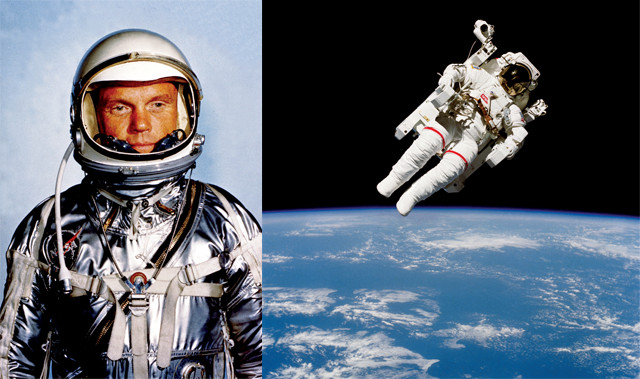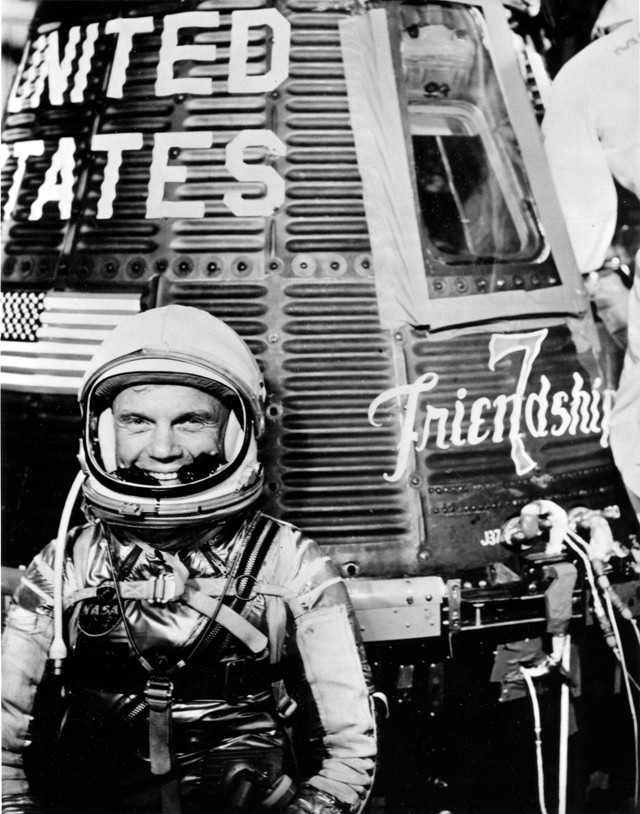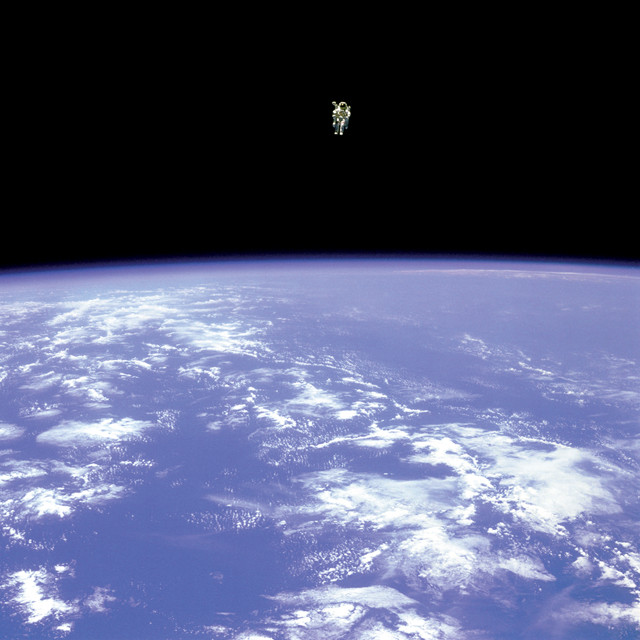
by Lucas Joel Tuesday, February 2, 2016

Left: Astronaut John H. Glenn Jr. in his Mercury flight suit. Right: Astronaut Bruce McCandless pilots the Manned Maneuvering Unit during the first untethered spacewalk on Feb. 7, 1984. Credit: both: NASA.
On the morning of Feb. 20, 1962, John H. Glenn sat inside the Mercury Friendship 7 space capsule, perched atop a rocket that had initially been designed to deliver nuclear warheads to the far ends of the world. That rocket would propel Glenn into space, and into the history books, as the first American to orbit Earth.
A far cry from earlier visions of futuristic space planes that would ferry humans into space, the Atlas intercontinental ballistic missile (ICBM) was the quick and dirty way for a newly formed U.S. government agency called the National Aeronautics and Space Administration (NASA) to get an American into orbit. It was a feat that the Soviet Union — the U.S.’s Cold War and space-race rivals — had achieved the year before in April when Yuri Gagarin became both the first human in space and the first to orbit Earth.
Although not the first American to reach space (that distinction went to Alan B. Shepard on May 5, 1961), Glenn was the first American to match Gagarin’s achievement, which immediately lofted him into the national spotlight.
Cold War tensions between the U.S. and the Soviet Union helped spark the space age, which, in the decades after Glenn’s orbit, saw many more astronaut achievements. One of those milestones occurred 32 years ago when Bruce McCandless — an astronaut and electrical engineer — was orbiting the planet as part of a mission on the space shuttle Challenger. On Feb. 7, 1984, McCandless exited the shuttle’s payload bay strapped to a large backpack-sized vehicle called a Manned Maneuvering Unit (MMU), which propelled him into space completely unconnected to the shuttle. It was the world’s first untethered spacewalk.

Glenn poses for a photo with the Mercury Friendship 7 spacecraft during preflight preparations. Credit: NASA.
Dreams of human space travel began to materialize in the mid-20th century after key advances in rocket science came about during World War II. With the efforts of Wernher von Braun and other scientists and engineers, Germany developed the V2 rocket, the first long-range ballistic missile.
<“iv>” “Rocketry was pretty amateurish up until the 1930s, but thanks to defense developments during the war, traveling into space began to seem less and less nutty over time,” says Michael Neufeld, senior curator in the Division of Space History at the Smithsonian’s National Air and Space Museum. “And with the end of World War II, the V2 opened the door to the launch of the ICBM and, in that way, the space launch vehicle.” It was not until the early 1960s, though, that rockets large enough to carry a warhead anywhere on the planet — or launch a spacecraft into space — were developed.
Prior to Glenn’s 1962 launch, the Soviet Union had outpaced the U.S. in the space race. After the 1957 launch of the Soviet satellite Sputnik, U.S. President Dwight D. Eisenhower committed government funds to accelerate the nation’s fledgling space program. At first, the responsibility of reaching space fell to two branches of the military: the Army and the Air Force, both of which were, for defense purposes, interested in developing a presence in the upper reaches of the atmosphere. “It would’ve been a perfectly reasonable outcome of the Cold War situation that the U.S. space program would have been military-based,” Neufeld says. However, conflicts between military branches — and the fact that each wanted to have the strongest foothold in space — helped drive Eisenhower to establish a separate, civilian space agency: NASA. The creation of a civilian-run space program was also meant as a statement, Neufeld says, in the Cold War propaganda battle: “NASA was a good image for the United States because it represented a supposedly peaceful space program, rather than it being some kind of military-run missile initiative as with the USSR’s space program.”
After NASA came into being in 1958, it soon created Project Mercury, the goal of which was to put an American into orbit. Seven military test pilots were chosen to be part of NASA’s first astronaut corps. One of these pilots was John Glenn, who had flown combat missions in World War II and the Korean War. Glenn, before his flight, named his space capsule Friendship 7: Like Alan Shepard’s Freedom 7 capsule, the name was a nod to his fellow Mercury astronauts.
Glenn’s launch day — Feb. 20 — arrived, and by 6 a.m. Eastern time he had donned his spacesuit and climbed inside the cramped quarters of Friendship 7, about which he joked: “You don’t get into [it], you put [it] on.” At 9:47 a.m., the engines were lit, and five minutes later Glenn rocketed into orbit.
Outside his window, Glenn passed over the coast of West Africa, and then over the Indian Ocean, which is where he saw his first sunset from orbit: “A beautiful display of vivid colors … As the sun gets lower and lower, a black shadow moves across the Earth until the entire surface that you can see is dark except for the bright band of light on the horizon. At the beginning, this band is almost white in color. But as the sun sinks deeper the bottom layer of light turns to bright orange. The next layers are red, then purple, then light blue, then darker blue and finally the blackness of space. They are all brilliant colors, more brilliant than in a rainbow.”
After three orbits over 4 hours and 55 minutes, Glenn returned to Earth and splashed down in the Atlantic Ocean. Shepard may have been the first American in space, but he had not orbited the planet like Gagarin had. “The Soviets orbited Gagarin on the first try, while Shepard made a 15-minute flight up into and then immediately back down from space,” Neufeld says. To Americans at the time, this “seemed like an inferior accomplishment.” Glenn’s orbit thus eclipsed Shepard’s flight and for that, New York City and Washington, D.C., held parades in his honor. The flight came to signify the country’s first major step into the space age.

McCandless floats about 100 meters from the space shuttle Challenger during the first untethered spacewalk in 1984. Credit: NASA.
In the years following Glenn’s flight, American space exploration expanded: Astronauts first orbited and then landed on the moon in 1968 and 1969, respectively, and, from 1981 to 2011, NASA’s space shuttles ferried astronauts into space on numerous exploratory and scientific missions. In 1984, on one of these shuttle missions — STS-41B — astronaut Bruce McCandless performed the first untethered spacewalk from the space shuttle Challenger. (During a subsequent mission on Jan. 28, 1986, Challenger exploded just after launch, killing all seven astronauts aboard.)
For the spacewalk, McCandless used an MMU that was designed to enable him to roam free of the space shuttle. Departing from the payload bay, McCandless ranged about 100 meters from the shuttle, becoming the “first human satellite,” says Valerie Neal, curator and chair of the Smithsonian’s Space History Department. While adrift, fellow astronaut Robert Gibson, from inside Challenger, snapped a photo that went on to become an iconic image of human space travel. In the photo, a solitary McCandless, visor down to protect his eyes from the sun, appears suspended in space far above Earth’s horizon.
The MMU that McCandless flew, which is now on display at the National Air and Space Museum, was designed so that astronauts could perform tasks at a distance from the spacecraft, such as retrieving a damaged satellite. This would keep the shuttle itself from having to get close to other bodies floating in space. “McCandless himself invested a great deal of his career into developing the MMU capacity,” Neal says. “He, more than any other astronaut, is associated with the MMU, both for the fact that he flew it first and because he had put in years of effort developing it and perfecting it to be an astronaut aid.”
Including McCandless’ flight, the MMU was used on just three shuttle missions. Following the 1986 Challenger explosion, NASA “became a lot more conservative regarding astronaut safety,” Neal says. It was decided that most of the tasks the MMU was designed to help accomplish could be done just as well with the space shuttle’s robotic arm.
“Had the Challenger tragedy not happened, I think it’s likely that the MMU would have continued to be used,” Neal says. “It probably would’ve evolved into a smaller, more compact version [of the] one McCandless used,” and perhaps would have been used to help build the International Space Station, she says. Unfortunately, its “potential for making astronauts even more capable workers in space” was never realized.
© 2008-2021. All rights reserved. Any copying, redistribution or retransmission of any of the contents of this service without the expressed written permission of the American Geosciences Institute is expressly prohibited. Click here for all copyright requests.